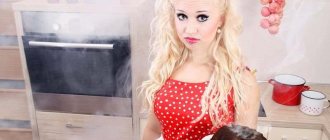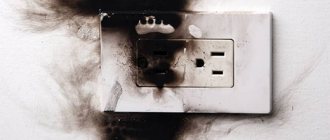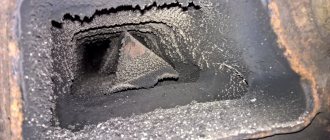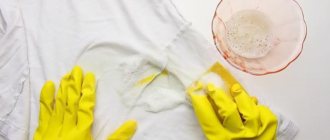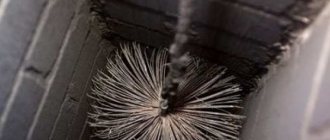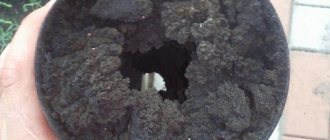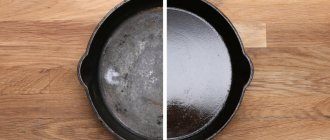soot and soot on a brick wall
How to remove soot from brick? To do this, you can use one of the following methods:
- wet cleaning with a sponge;
- use detergents and a vacuum cleaner;
- folk remedies (for example, vinegar);
- special modern cleaners.
Depending on which cleaning method you choose, different tools will be useful. A general list might be something like this:
- gloves;
- a hose with a nozzle attached to it;
- broom;
- the brush is hard;
- powerful vacuum cleaner;
- rake.
Wet cleaning of brick surfaces from soot
Wet removal of soot from bricks
These instructions will help you remove soot from your fireplace. The method is very simple: 1. Prepare a large rag, sponge and mop. 2. Cover the floor with film - this will protect it from excess ash stains. 3. Mix a little powder and 30 grams of salt with enough water to form a paste-like consistency. 4. Moisten the work surface with a moistened sponge - you need to start doing this from top to bottom. 5. Foam the detergent and apply it to the wall. 6. Leave for 15 minutes - it is important to focus on the fact that the foam should turn black. 7. Remove the foam using a nylon brush - if the dirt is not so advanced, then it will fall off along with the soot. If necessary, the procedure can be repeated. If the goal was not achieved this time, then more aggressive methods of influence should be used.
Treatment with vinegar
removing soot with vinegar
It's good to have a proven detergent on hand. If you don’t have one on your household, then simple vinegar will do. The principle of working with it is similar to the previous one - first you will need to moisten the wall, and then apply vinegar. And only after some time has passed it will be possible to process the brick with a brush.
- A good analogue to vinegar can be ammonia, which will need to be mixed with water (half a glass per bucket of water). After this, the treatment area is also rubbed with a brush, and then rinsed thoroughly. In both cases, do not forget to ventilate the premises, since the vapors of both of these compounds are harmful to health.
Connecting the washing vacuum cleaner
If you have this miracle of household appliances in your home, then you can safely take it as your “assistant” in the fight against contaminated surfaces. In this case, it is better to dilute washing powder in a bucket of water and add 30 grams of salt, but, of course, you should focus on the area of work. A little advice - if you have to clean a lot, then it would be best to put it on a cart with wheels and thus drag it along with you. The work can be very dirty, so be sure to dress appropriately in advance. But it is better not to treat old brick in this way - it can be damaged under running water.
Special detergents
If we rely on the experience of professionals, then when it comes to the question of how to remove soot from bricks, specialists from cleaning companies will not use folk remedies.
There are specially developed potent drugs that are sold in regular hardware stores.
We can recommend Neomid 550, Antisolex or Tiprom OC impregnation. Having them in your arsenal, act as follows:
- Wear rubber gloves and an eye mask to protect skin surfaces.
- Protect walls, fabrics and carpets from contact.
- Mix half a glass of the product in three liters of hot water.
- Treat the surface with a stiff brush.
- When finished, wipe the surface with warm water.
After the brick has dried, you can evaluate the result. Such an event should be held at least once a year. If the contaminated brick wall is external, then it is best to plan to do it after heavy rains or several months of the dry season have passed.
How to remove soot from brick
The centuries-old experience of combating this scourge has developed many methods, and the modern arsenal of economic means has significantly accelerated the process.
A soot fighter cannot do without the following in his arsenal:
- household gloves,
- hose with a special nozzle,
- sponges,
- hard brush,
- vacuum cleaner.
Wet cleaning of bricks
The easiest and most well-known solution is to wash the brickwork; this process does not require much effort. Before we begin, let's prepare a special solution.
Make a mixture of washing powder and salt (within 30 grams), add water to form a paste.
The required amount of powder depends on the level of contamination and the size of the surface to be treated.
If you are going to wash the walls indoors, cover the floor with polyethylene or paper.
Then pre-moisten the contaminated surface with water; to do this, use a sponge, brush, spray bottle, or other available materials. Start at the top and gradually work your way down.
Beat the prepared paste until foam is obtained and apply to a moistened wall. Leave the foam for 15-20 minutes, monitor the process by darkening the foam layer.
To wash off, use the prepared brush. This method is applicable if the contamination is light.
Special means
Employees of cleaning companies use professional household chemicals to combat soot. The substances are effective in cleaning stove chimneys and fireplaces. The products are sold in both specialized and regular hardware stores.
Source sdelai-lestnicu.ru
Before you wash soot off brick, I’ll tell you about the available preparations. Among the popular ones I will highlight 4 types:
- "MAZBIT PLUS". I use a concentrated product based on composite alkali and additives to remove combustion products from any surfaces. Safe for high pressure cleaners. For 5 squares I spend 1 kg of substance.
- "Neomid 550". I use an anti-efflorescence agent to remove soot. A concentrated acid-based preparation intended for stone surfaces. Solution consumption – 250 ml per 1 m2.
- "Antisolex". Facade impregnation consists of a combination of acid salts and an antiseptic. Efflorescence remover works well on soot on bricks. A liter of the drug is enough to treat 15 squares.
- "Tiprom OC" A professional acid cleaner will get rid of combustion products. Consumption – 1 l per 4 m2.
All drugs have the same principle of action, only different concentrations. I dilute the substance according to the instructions, and treat the walls generously with a sponge, brush or construction roller. Depending on the intensity of the contamination, I remove the solution with warm water after 15-30 minutes.
Wet cleaning method
How to clean soot from a brick? Cleaning a fireplace in a wooden house is the simplest and most common method; you don’t have to do any special effort during the work. First you need to prepare all the necessary tools and cleaning products. Next you need to proceed as follows:
This method is suitable for traditional cleaning and may not be useful in cases of heavy contamination. Then the procedure can be repeated, but it is best to carry it out using more effective methods.
Mechanical soot removal technology
The most effective method to quickly bring a chimney back to normal is mechanical cleaning. The work is labor-intensive and requires the performer to comply with a number of rules.
Chimney sweep tools and equipment
Chimney cleaning devices used many years ago are still relevant today.
Indicative list:
- A metal brush with a diameter 20-30% larger than the cross-section of the chimney. For square pipes, a stiff brush is selected.
- Cable and brush holders.
- Steel round core with cable and carabiner. The diameter of the weight is 2/3 of the chimney section.
For cleaning, it is better to choose a brush with nylon hard bristles.
Polyamide bristles take the shape of the channel, and unlike a metal scraper, do not scratch the internal walls of the chimney. The high flexibility of nylon helps to get rid of plaque in hard-to-reach areas of the chimney
Before doing dirty work, you need to take care of personal protective equipment - wear long sleeves, glasses, a respirator and gloves, and put on boots with non-slip soles.
Working Conditions: Basic Safety
It is important to take the following precautions during the cleaning process:
- The inspection hatches of the chimney must be closed so that soot does not get inside the room and spoil the finish. Cover the open fireplace with a damp cloth.
- Work is carried out in calm, dry weather.
- Be sure to use a safety rope and belt.
- It is advisable to enlist the support of one responsible assistant.
- It is strictly forbidden to start cleaning while drunk, tired, or after taking medications that slow down the reaction.
It is necessary to inspect the chimney in advance for the presence of foreign objects, for example, bird nests.
If the socket is low, then it needs to be pushed in the direction of the combustion chamber. A high-positioned object can be reached from above
Step-by-step process of chimney cleaning
The whole process consists of several steps:
- Remove the pipe head from the top of the chimney and use a broom or long stick to remove visible dirt.
- Perform a test run with a weighting agent. The core should split large layers - small fragments will fall into the firebox.
- When the patency of the canal is restored, pull out the cable and connect the brush to the core.
- Clear a small area by lowering and raising the rope.
- Clean the rest of the chimney in the same way.
- Check the inspection chamber and remove any fallen soot.
The described technology is effective for straight chimneys - even at an angle of 45°, the passage of the core will be difficult.
Multifaceted professional brushes on a flexible shaft are designed for cleaning chimneys, ventilation systems and sewers. Markings on the cable allow you to control the depth of passage
How to remove fumes from brick
Soot getting on a brick wall greatly spoils its appearance. This is especially true for a fireplace or stove in a bathhouse. The edges of the brick, due to their porosity, quickly absorb soot, which is quite difficult to clean. But there are still ways to clean such a surface.
- At the first stage, wet processing will help. Moisten the soot-covered surface with clean water. This can be done with a sponge or rag using light strokes from top to bottom. Prepare a paste by mixing some washing powder and 30 g of table salt with a little water. Beat this mixture into a foam and apply it to the wall with a sponge. After about 15 minutes, after the foam has turned black, remove it with a brush. If the contamination is severe, the procedure can be repeated.
- If wet treatment does not give the expected result, you must proceed to the second stage of cleaning. Moisten the wall and apply table vinegar to the smoky area. After some time, the brick can be washed with a brush. Instead of vinegar, you can use ammonia, half a glass of which must be diluted in a bucket of water. After treatment, the surface must be thoroughly rinsed with clean water. Do not forget to intensively ventilate the room while working, since the vapors of these solutions are harmful to health.
Method number 1. Water + vinegar
Water and white vinegar (9%) taken in a 1:1 ratio help to clean the fireplace from soot. First, scrape off soot from the walls of the fireplace, which easily “comes off” from the brickwork. Pour the solution into a spray bottle and apply it to the smoked surface of the fireplace. After a few minutes, apply a second “coat” of your cleaner, and while it’s still wet, brush the bricks in a circular motion from top to bottom (to avoid streaks).
From plaster on brickwork
Quite often, brickwork is completely plastered. Over time, this finish loses its original appearance and there is an urgent need to update the walls in the room. An excellent option is to remove the old layer of plaster and renew the brickwork. This option will perfectly update the interior.
To properly remove plaster you need:
- Remove all furniture from the premises.
- Close all cracks tightly to prevent dust from entering other rooms.
- Prepare a hammer, chisel, brush.
- Remove the layer of plaster.
- Clean the wall from dust.
- Cover the surface with varnish.
Using a chisel and hammer, you need to remove the layer of plaster. You need to start from the top corner and gradually move down. The tool must be held at an angle.
During work, the plaster must be constantly removed from the room so that it does not accumulate underfoot and interfere with work. After upholstery, use a brush to remove all small particles and dust from the wall.
Then you need to wash the brick. Using a wet cloth, you need to clean the walls, starting from the top corner. To give brickwork a beautiful appearance, you can use a special varnish.
Walls
The appearance of soot on the walls is provoked by many factors, such as excessive flame in the fireplace, stove, boiler or fire. In any case, this phenomenon must be eliminated. Since soot spoils the appearance of the walls and reduces the aesthetic appeal of the room. We will learn further about how to remove soot and how to clean soot.
Table of contents:
- How to clean soot after a fire with your own hands
- How to clean soot from walls: step-by-step work
- How to clean the walls of copolis in a bathhouse
- How to clean soot from metal
- How to clean soot from a ceiling
- Methods for cleaning brick from soot
How to clean soot after a fire with your own hands
After a fire of any complexity, the walls, ceiling and objects in the room are covered with soot and soot. There are several options for products suitable for removing soot from walls.
In order to determine the most effective method of getting rid of soot, it is necessary to study its structure. First of all, soot is a sticky mass that contains remnants of materials that burned during a fire. Therefore, depending on the type of these materials, both sticky, greasy and dry soot are emitted. To get rid of soot, aggressive methods are most often used.
Before you start working on cleaning the walls from soot, follow these steps:
- inspect the walls for the nature and level of soot on their surface;
- remove materials that cannot be restored;
- determine the most effective way to clean the walls, in relation to the type of soot that is present on them;
- clean the walls from soot using available materials;
- eliminate the burning smell;
- ventilate the room.
Please note that during the cleaning process it is recommended to use only non-toxic substances. Using disinfectant solutions, it is possible to remove unpleasant odors in the room.
Before you start cleaning, check the room, as the smell left after a fire has a negative impact on human health. When cleaning walls from soot, use rubber gloves and a mask. It is advisable to cover your hair with a headscarf, wear old clothes that you don’t mind getting dirty with soot and then throwing away. Please note that the entire body should be covered with clothing, as it will be quite difficult to wash off the soot.
Before removing soot, prepare materials in the form of:
- plastic bowl;
- high-power vacuum cleaner;
- a large number of unnecessary rags;
- special chemical sponges that are sold in hardware stores;
- broom;
- brushes with stiff bristles;
- spatula and brushes;
- roller and container for it.
In addition, it is necessary to select a number of chemicals that will help get rid of soot on the walls.
How to clean soot from walls: step-by-step work
The first stage of work in a room after a fire is getting rid of unnecessary garbage and burnt things. If you have charred furniture, remove it from the room. Surviving items in the form of carpets, paths, curtains must be ventilated outside to remove the unpleasant burning smell. If you cannot get rid of the smell, then thoroughly wash the curtains with powder and rinse aid, and to clean carpets, use chemicals or take them to a dry cleaner.
Unfortunately, it will not be possible to remove the smell from unaffected books, so either throw them away or place them in a room where you do not visit often so that they do not spread the burning smell.
If the wallpaper in the room is burnt, then it is necessary to remove it from the walls and take it outside, the same should be done with the burnt floor covering, plastic objects, baseboards, etc.
After getting rid of all the items in the room, move on to the second step, which is to perform dry cleaning. If the floor in the room is not damaged, then before you start cleaning the walls, lay a film on it and secure it with tape. Next you should do the following:
- remove wallpaper or paint on the walls;
- Using a vacuum cleaner, clean the walls from burning and soot, thoroughly treat the cracks;
- to remove dirt, use a brush with stiff bristles or a broom; try to sweep away soot from the wall, but do not rub it into the surface;
- for further cleaning, use special chemical sponges, impregnated with a composition that helps in washing soot from the walls;
- do the work starting from the bottom, gradually moving up the wall;
- After the upper part of the sponge is clogged, it is removed.
After dry cleaning, start cleaning the area. To do this, you will need to prepare clean water, rags and containers in the form of buckets or basins. As a detergent, use regular dish gel or baking soda with hot water. Do not press the rag while wiping off the soot; lightly wipe the surface with it. As soon as the water turns dark, replace it with new water. Wash the walls several times; if soot still remains on them, use a stiff brush soaked in dishwashing gel to remove it.
Please note that it is prohibited to carry out wet cleaning immediately after a fire. Initially, it is necessary to remove most of the soot with a vacuum cleaner and dry rags, only after that the soot is removed with water. In order to neutralize the remaining soot on the wall, it is recommended to apply a sealant to it. Next, the walls are covered with soil. To further purify the air from unpleasant odors, special chemical neutralizers are used.
In addition, air purification is carried out by special cleaning companies using ozonizers. In order not to buy this equipment, rent it or hire specialists who will clean the air in the room professionally and quickly.
It is with the help of ozone that it is possible to very quickly clean the room from the smell of burning. This substance has excellent disinfectant characteristics. To use this material, it is enough to turn on the equipment for a certain time until the odor is completely removed from the room.
If it is not possible to purchase an ozonizer, put water on the stove, which should boil for about 6-8 hours. Soak clean rags in vinegar and place them around the house. Change rags periodically, as they quickly absorb unpleasant odors. If you have a bathroom, turn on the hot water and open the door to allow steam to enter the air and clean it. It is possible to make your own special solution that will help remove the burning smell from the room. To do this, connect the following components to each other:
- baking soda - forty grams;
- hydrochloric acid - the same amount;
- ammonia - forty grams;
- any container made of tempered glass.
To prepare the solution, combine ammonia and soda. Next, add acid to the resulting composition. The reaction will produce white smoke called ammonium chloride. It is he who is able to remove the smell of burning in the room. Leave the mixture in the room for 24 hours, close all doors and windows tightly and leave the house. Then ventilate the room for several hours or days, depending on the degree of burning. After that, start doing renovations indoors. There will be no burning smell in the room.
How to clean the walls of copolis in a bathhouse
In most cases, after several years of using the bathhouse, soot appears on its walls or ceiling. Since natural wood is most often used to build a bathhouse, it absorbs not only moisture, but also soot particles, losing its former attractiveness.
There are several methods for cleaning walls from soot, we suggest you familiarize yourself with them:
How to clean brick
Today, when building a country house or other structure, brickwork is used. The building, built of brick, looks not only solid, but also quite attractive from an aesthetic point of view. The fact is that when ordering a project, the owner of the future home can experiment not only with the external appearance of the building, but also with the color scheme of the brick. Most often you can find mansions built from red brick, and it is used everywhere, since this material has such characteristics as resistance to external influences, strength and non-flammability, so brick is perfect for the construction of stoves and fireplaces. At the same time, brick buildings in some cases do not require absolutely no external finishing.
Often, after construction work is completed, the brickwork remains in a very unsightly condition. Traces of mortar, dirt and dust leave unsightly stains and streaks on the brick wall. Ultimately, this becomes the main problem for the owner of the building, since unattractive stains on the brick leave a feeling of unfinished construction and an untidy appearance.
There are many ways to clean mortar from brick. Experts identify three main methods for cleaning brickwork from traces of mortar:
- mechanical cleaning with a stiff brush, which allows you to remove remaining cement and dirt from the brick;
- washing with water;
- special cleaning of brickwork using various pastes.
However, no matter how good these methods are, it is worth paying attention to each of them separately, since they are not always acceptable in different situations.
Mechanical cleaning
Mechanical cleaning of bricks
Mechanical cleaning of bricks is good only in cases where we are talking about building masonry bricks, since they are strong enough and will not be damaged even by the use of the most radical cleaning methods.
Note! As for facing bricks, you should be careful here, as they are quite fragile and intensive cleaning can simply destroy them.
Using an aqueous solution
Using an aqueous solution
The use of an aqueous solution also poses several dangers. Sometimes, due to dampness, a greenish coating of mold appears on the brick, which is easily washed off with water from a hose. However, after some time, the home owner will be surprised to discover that the stains not only have not disappeared, but are also getting larger.
Method number 3. Cream of tartar + water
One of the most effective “folk” ways to clean soot from fireplace glass and brick fireplace walls is a paste made from cream of tartar and water. Cream of tartar is a white powder made from cream of tartar. Externally, it looks like baking soda. It is often used in cooking as a substitute for baking powder, but it is also good for clearing soot from a fireplace.
To make a cleanser from cream of tartar, take 2 tablespoons of the powder and add a little water. Apply the paste to the smoked areas and leave for 5-10 minutes. After this, rinse with warm water. If desired, soda can be replaced with salt. And don’t cook a lot of pasta at once, so you don’t have to throw away the excess later.
A fireplace in the living room is beautiful, but a smoky fireplace looks unpresentable and can ruin all your interior design efforts. If you want your fireplace to always look beautiful, clean it of soot regularly. And try to heat it with aspen wood once every 2 weeks. They provide little heat, but it has been observed that they clean the chimney well of soot and soot.
If you liked the article, please like it! And don't forget to subscribe to our channel on Zen!
Source
Preparation
You need to start cleaning your apartment after even a minor fire with preparatory measures. It is better to prepare everything in advance to ensure a successful wash. They take into account in which rooms the surfaces need to be cleaned and what material they are made of. The quantity of soot and its quality play a role. It is necessary to clean everything so that soot particles do not eat into the walls and furniture.
Degree of pollution of the apartment
The quality of soot cleaning in an apartment depends on the degree of its settling on the surface. If everything is covered with a thick layer of soot, then you will have to have the furniture professionally cleaned. And some items will have to be thrown away. After all, they will emit a smell in the apartment for a long time, which is difficult to get rid of.
Taking things out
Before cleaning, all things are taken out, completely emptying the rooms. This makes it easier to deal with major contaminants. If possible and weather conditions permit, then take objects and things into the open air. In winter you can go to the balcony or loggia, or to the basement.
Removing curtains, drywall, carpets, baseboards
A room free of furniture is cleared of those things that cannot be washed immediately:
- If the curtains on the windows are just dusty, then they can be washed thoroughly in an automatic machine. Covered with a thick layer of soot, you can’t clean it off. You should say goodbye to them.
- Walls and plasterboard products will be cleaned using dry methods. But the fumes are deeply embedded in them, so it is better to replace such parts of the interior with new ones.
- Carpets strongly absorb odors and soot particles, so they must be removed. It's worth getting them dry cleaned.
- The question of whether it is worth tearing off the baseboards should not arise. To prevent soot from remaining inside them, they are removed. It is better to replace them with others over time. Plastic ones can be washed and reattached after cleaning.

